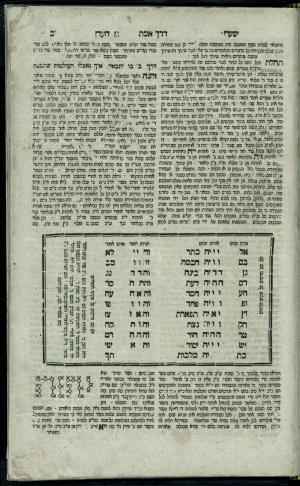Obj. ID: 39450
Jewish printed books Sha'ar Gan Eden by Ya'akov Kopel Lifschitz, Korzec, 1803

This text was prepared by William Gross:
Sha’ar Gan Eden, Kabbala. By Rabbi Ya’akov Koppel Lifshitz of Mezrich. Korets [1803]. First edition. Approbations by Rabbi Levi Yitzchak of Berdychiv, Rabbi Meir of Brad, Rabbi Ephraim Zalman Margaliot etc. “Straight path… in depths of wisdom… based upon Kabbalah of the Ari”. Includes Kabbalistic illustrations. Mentioned on title page that manuscripts of this book were presented to the Ba’al Shem Tov upon his visit to Mezrich. He read them, embraced and kissed them and nodded "Fortunate is the nation…".
The author of this work also wrote the noted Kol Ya’akov, which is also known as the “Siddur Rav Koppel”. It features the Arizal’s kavanot for the prayers. See Gross Family Collection B.
Kabbalist Rabbi Shabbetai of Rashkov, a disciple-colleague of the Baal Shem Tov, also authored a prayer book with the kavanot of the Arizal – known as the Siddur Rabbi Shabbetai. He was greatly influence by Rabbi Ya’akov Koppel’s work. Rabbi Shabbetai saw Rabbi Koppel’s work in manuscript form, before it was printed. Rabbi Koppel Lipschitz was greatly esteemed by the Besh”t. When the Besh”t saw the manuscript “he hugged and kissed them” “and he used a lot of energy to hug with his arms the author’s writings”, as mentioned on the title page and approbations. Includes kabbalistic diagrams.
The community in Korzec, where this volume was printed, was one of the oldest in Poland. Jews were living there in the 13th century. During the Chmielnicki massacres in 1648/49 the community was almost annihilated, but recovered soon afterward to become the most influential in the council of four lands. A textile factory established by Joseph Czartoryski in Korzec at the end of the 18th century employed 120 Jewish workers.
Between 1766 and 1819 there were four Hebrew printing presses in Korzec, some of them associated with those in Shklov, Nowy Dwór, and Ostrog. They printed nearly 100 books, mostly works of kabbalah and chasidism, which contributed considerably to the spread of Hasidism in poland and adjoining countries. Works by Jacob Joseph of Polonnoye and Dov Baer of Mezhirech were first printed there. Korzec was a center of Hasidism. Dov Baer the maggid of Mezhirech and Phinehas Shapiro were active there.
[2], 84 leaves.
The community in Korzec, where this volume was printed, was one of the oldest in Poland. Jews were living there in the 13th century. During the Chmielnicki massacres in 1648/49 the community was almost annihilated, but recovered soon afterward to become the most influential in the council of four lands. A textile factory established by Joseph Czartoryski in Korzec at the end of the 18th century employed 120 Jewish workers.





